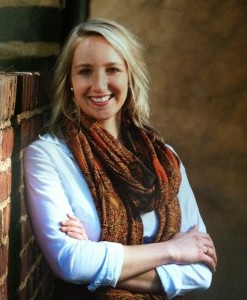Following the Food Chain Back to Bon Appétit
Editor’s Note: The third year of our much-loved first West Coast Fellow, Vera Chang, has concluded and she has moved on to bigger and better things. Please join us in welcoming Claire Cummings, who explains below how she came to join us.
 In Portland, OR, each year, Lewis & Clark College hosts a four-day-collegiate conference called the Environmental Studies Symposium. The symposium is designed and coordinated by students, and my junior year I was selected as one of the lead co-chairs.
In Portland, OR, each year, Lewis & Clark College hosts a four-day-collegiate conference called the Environmental Studies Symposium. The symposium is designed and coordinated by students, and my junior year I was selected as one of the lead co-chairs.
The theme for 2010 was “Following the Food Chain,” and I have to admit I wasn’t initially thrilled. The topic seemed like “low-hanging fruit” compared with issues of climate change, pollution, and alternative energies. However, as I began reading books such as Julie Guthman’s Agrarian Dreams and speaking to community experts such as Camas Davis from the Portland Meat Collective, I began to understand the deep connection between food and the environmental problems I was concerned about.
In hopes of making the “wild web” of food issues accessible to a wider audience, my team collaborated with the staff of Bon Appétit Management Company, our campus food service provider, to create an interactive dining experience for our attendees. We designed three different meals that represented significant decisions consumers make when choosing what to eat. Ingredients ranged from locally and humanely produced beef to fruits shipped from far away countries and seafood raised in environmentally devastating ways. Each ingredient told a story of life before the plate and forced attendees to recognize their participation in America’s broken food system.

Maisie's 2010 panel sparked Claire's interest in Bon Appétit
It was at this dinner that I met Maisie Greenawalt, Bon Appétit’s vice president of strategy and the president of its foundation arm. I was already familiar with Bon Appétit at that point; in addition to the symposium, I was in the midst of trying to run the Real Food Calculator in our college café. I was also a frequent patron; even though I lived off campus, I knew some days Bon Appétit would feed me better than I could feed myself!
Yet during all these experiences, it never hit home that Bon Appétit wasn’t just following the food movement, but was using their purchasing power to change the food industry for the better.
At dinner, Maisie spoke about her meeting with the leaders of one of the largest meat producers in the world. Upon hearing this, at least a few people in the room gasped as if she had shaken hands with the devil, but she stood her ground. She explained that Bon Appétit uses its purchasing power to improve the production standards of some of the biggest offenders in the food system. As a valued client of this producer, Bon Appétit can generate enough demand for a better product (such as chickens raised without the routine use of antibiotics) to encourage it to take a step, however small, toward more sustainable food production.
I was floored. I had believed that social change came from the world of nonprofits. How could do-gooders both stay true to their vision and make money? Didn’t that take grants and volunteers and 501c3 status? It was exciting to see true sustainability at work: a for-profit business model that was also loyal to a socially responsible mission.
From then on, I knew I wanted to work for Bon Appétit. When the Fellowship opened up I was ready for it. My new position is a welcome shift from the world of nonprofit advocacy into the realm of corporate responsibility. Even though the context has changed, not much else has; I still get to advocate for better industry practices, research new ways of doing things, and educate people on the importance of food choices. I am thrilled to work for a company I deeply respect, in a position that brings together all that excites me about food.
I sure am glad I made it back to Bon Appétit!